
Correa is a genus of eleven species of flowering plants in the family Rutaceae that are endemic to Australia. Plants in the genus Correa are shrubs to small trees with simple leaves arranged in opposite pairs, bisexual flowers with four sepals, four petals usually fused for most of their length and eight stamens.

Correa lawrenceana, commonly known as mountain correa, is a species of shrub or small tree of the family Rutaceae and is endemic to Australia. It has elliptical to egg-shaped leaves arranged in opposite pairs and cylindrical, greenish yellow to red flowers usually arranged singly or in groups of up to seven in leaf axils with the stamens protruding beyond the end of the corolla.
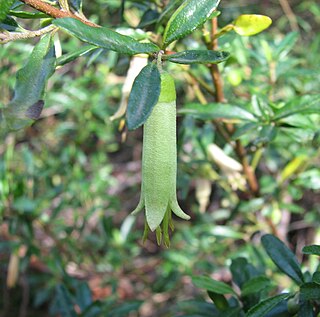
Correa glabra, commonly known as the rock correa, is a species of tall, erect shrub that is endemic to Australia. It usually has elliptical, mostly glabrous leaves and pendent, pale green to pale yellow flowers arranged singly on short side shoots.
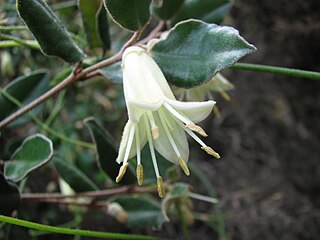
Correa backhouseana is a species of rounded shrub that is endemic to coastal and near-coastal areas of southern Australia. It has elliptical to egg-shaped or round leaves that are densely hairy on the lower surface, and cylindrical to funnel-shaped, cream-coloured to pale green or red and yellow flowers.

Correa decumbens, commonly known as the spreading correa, is a species of prostrate to spreading shrub that is endemic to South Australia. It has narrow oblong to narrow elliptical leaves and narrow cylindrical, pink to red flowers with green lobes.

Correa lawrenceana var. grampiana, commonly known as Grampians mountain-correa, is a variety of Correa lawrenceana that is endemic to Victoria, Australia. It is a shrub with elliptical leaves and cylindrical, velvety flowers covered with matted, woolly cream-coloured to yellowish brown hairs.
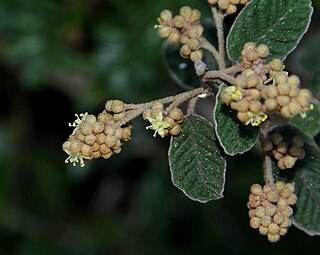
Pomaderris oraria, commonly known as Bassian dogwood, is a species of flowering plant in the family Rhamnaceae and is endemic to south-eastern Australia. It is a compact shrub with hairy branchlets, hairy, elliptic leaves and panicles of hairy, greenish to cream-coloured or crimson-tinged flowers.

Pomaderris lanigera, commonly known as woolly pomaderris, is a species of flowering plant in the family Rhamnaceae and is endemic to south-eastern continental Australia. It is a shrub or small tree with hairy stems, lance-shaped to egg-shaped or elliptic leaves, and hemispherical clusters of yellow flowers.

Persoonia juniperina, commonly known as prickly geebung, is a species of flowering plant in the family Proteaceae and is endemic to south-eastern Australia. It is a small erect to low-lying shrub with smooth bark, hairy new branches, linear leaves, yellow flowers borne singly or in groups of up to forty in leaf axils, and yellowish green to purplish fruit.
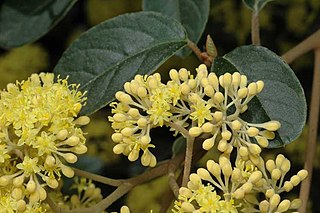
Pomaderris elliptica, commonly known as yellow dogwood or smooth pomaderris, is a species of flowering plant in the family Rhamnaceae and is endemic to south-eastern Australia. It is a shrub with densely hairy branchlets, egg-shaped or elliptic leaves, and pale yellow flowerss.

Boronia wilsonii is an erect shrub that is endemic to northern Australia. Its branches, leaves and backs of the flowers are densely covered with woolly hairs. The petals are white to pink or burgundy-coloured.

Correa lawrenceana var. cordifolia, commonly known as the pink mountain-correa, is a variety of Correa lawrenceana and is endemic to south-eastern Australia. It is a shrub with leathery, broadly egg-shaped to heart-shaped leaves, and pink flowers with yellowish tips arranged singly or in groups of two or three in leaf axils.
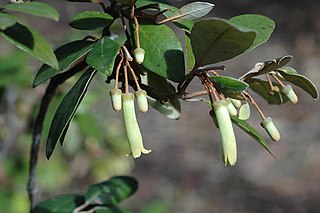
Correa lawrenceana var. glandulifera, commonly known as the mountain correa, is a variety of Correa lawrenceana and is endemic to eastern Australia. It is a shrub or small tree with egg-shaped leaves and greenish yellow flowers arranged singly or in groups of up to five with woolly hairs on the outside.

Correa lawrenceana var. latrobeana is a variety of Correa lawrenceana that is endemic to south-eastern Australia. It is a shrub or small tree with elliptical to egg-shaped leaves and cylindrical, greenish-yellow or reddish-mauve flowers arranged singly or in groups of up to seven in leaf axils or on the ends of branchlets.

Correa lawrenceana var. lawrenceana is the implicit autonym of Correa lawrenceana and is endemic to Tasmania. It is a shrub with papery, oblong leaves and pale green, narrow cylindrical flowers arranged singly on the ends of branchlets.
Correa lawrenceana var. macrocalyx is a variety of Correa lawrenceana and is endemic to New South Wales. It is a shrub with leathery, egg-shaped to broadly egg-shaped leaves, and cylindrical, greenish yellow flowers arranged in leaf axils or on the ends of short branchlets.
Correa lawrenceana var. rosea is a variety of Correa lawrenceana that is endemic to the Snowy Mountains of New South Wales. It is a shrub with narrow elliptical leaves and narrow cylindrical flowers that are pink or dull red with green lobes and covered with small, compact star-shaped hairs.

Goodenia benthamiana, commonly known as small-leaf goodenia, is a species of flowering plant in the family Goodeniaceae and is endemic to south-eastern Australia. It is an aromatic undershrub with stem-clasping, egg-shaped to elliptic leaves with toothed edges, and yellow flowers arranged singly or in groups of up to three in leaf axils, with leaf-like bracteoles at the base.

Pomaderris elachophylla, commonly known as lacy pomaderris, small leaf pomaderris or small-leaf dogwood, is a species of flowering plant in the family Rhamnaceae and is endemic to south-eastern Australia. It is a slender shrub with densely hairy branchlets, egg-shaped leaves, and cream-coloured flowers arranged singly or in clusters in leaf axils.

Olearia lepidophylla, commonly known as club-moss daisy-bush, is a species of flowering plant in the family Asteraceae and is endemic to southern Australia. It is a rigid, erect to spreading shrub with tiny oblong to egg-shaped leaves and white and yellow, daisy-like inflorescences.



















